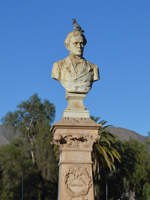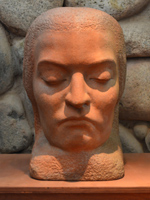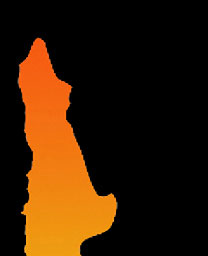

|
The Landscape of Poetry: Valle de ElquiVicuña is the birthplace of Gabriela Mistral, a poet who, like Pablo Neruda, was a winner of the Nobel Prize for literature. I began to explore the town in the morning, starting with the Plaza de Armas, the heart of any Chilean city. Vicuña has an especially charming plaza, with a surreal fountain at its center. The profile of Gabriela Mistral looks up from the base of the fountain, gazing straight up at the skies over her hometown. Statues mounted on pedestals pay homage to some of the town's other honored residents, and they always seem to have a pigeon seated on top. Brightly colored blossoms adorn the trees in the plaza, adding fragrant details to Vicuña in springtime. The usual lazy dogs are lying around the plaza, while young lovers stroll by and vendors sell aceitunas (olives) from small tables around the perimeter of the plaza. I sat in the plaza for a while this morning, watching it all go by and reading some of Gabriela Mistral's poetry. I can see the dry hills outside of town, and understand the way she described this valley. Van a mirarme los cerros
como padrinos tremendos, volviéndose en animales con ijares soñolientos, dando el vagido profundo que les oigo hasta durmiendo, porque doce me ahuecaron cuna de piedra y de leño. I walked from the plaza a few blocks down Calle Gabriela Mistral to the museum that is located at the poet's birthplace. I knew that she came from a very impoverished background, so I expected the Museo Gabriela Mistral to be a simple home with some spare furnishings. It was that and so much more. Gabriela's modest home was just a small part of the museum, preserved with dignity on a property that displayed in great detail the life and work of this Chilean poet. The museum was calm, cool, and quiet, an excellent ambience to absorb the chronological sequence of the milestones of Gabriela's life. She wrote about the natural environment with an observant sensitivity that reflected her outlook life. She traveled all over the world, sometimes as part of her work for the Chilean diplomatic corps and sometimes as the renowned literary giant that she became in her lifetime. From the Museo Gabriela Mistral I walked back to the plaza and found the tiny little Museo de Entomología y Historia Natural. I have quite a weakness for funky little natural history museums and this one was one of the best I've ever seen. Display cases housed spectacular butterflies from Bolivia, giant spiders from Brazil, and an incredible collection of bugs and insects from Africa, Thailand, and Malaysia. The Museo de Entomología y Historia Natural has a great collection of bugs, butterflies, beetles, and spiders. By now the heat of the afternoon was coming down with all its power. So I wanted to have a relaxing day, so I decided to take care of the biggest chore of the day right away, that is, finding a place to stay for the night. I went to the Visitor Center on the plaza and saw some pictures of a place that looked intriguing. It was called Kakanchik, and it was on the road that leads up to the Observatorio Mamalluco. It was here that I would spend a happy, but sad, last night in Chile. |
||||||||||
|
|||||||||||
 |
|||||||||||
|
© 2015 Michael Hanrahan
|
|||||||||||


